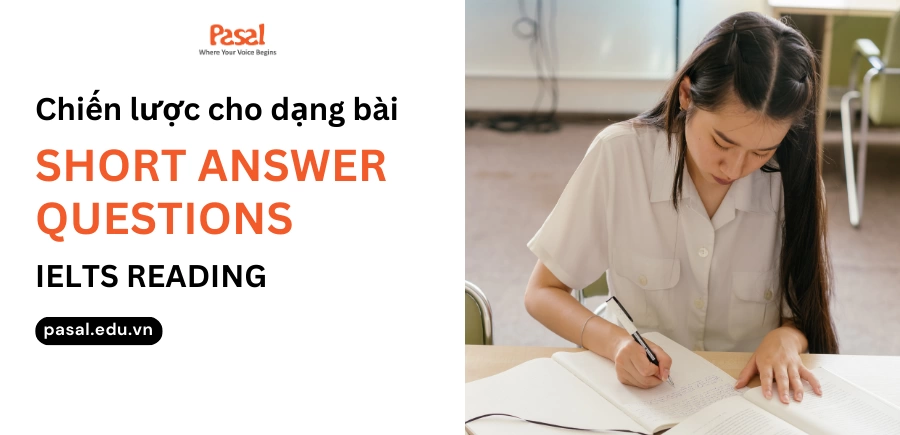Làm thế nào để đạt điểm cao bài thi IELTS Reading?
Phần thi đọc IELTS Reading đánh giá khả năng chắt lọc thông tin cụ thể từ các bài khóa của bạn cũng như việc bạn hiểu được đại ý của chúng. Các bài khóa IELTS Reading thường rất dài và nhiều chữ. Chúng thuộc nhiều chủ đề từ các vấn đề khoa học phức tạp cho đến các bài xã luận về tâm lý học và môi trường.
Trong bài IELTS Reading có thể có rất nhiều từ phức tạp mà bạn chưa biết, vậy làm thế nào để có thể đạt được điểm cao trong bài thi Đọc này? Pasal sẽ chia sẻ kinh nghiệm luyện thi Reading một cách tổng quát, mang đến cho các bạn những thông tin hữu ích trước kỳ thi.
IELTS Reading gồm những phần nào?
Phần thi môn Đọc gồm có 40 câu hỏi. Một vài loại câu hỏi được sử dụng để kiểm tra kỹ năng đọc. Các kỹ năng này bao gồm đọc để nắm bắt ý chính, đọc để hiểu các khái niệm chính, đọc để nhớ chi tiết, đọc lướt, đọc hiểu các lập luận chặt chẽ, và nhận ra quan điểm, thái độ và mục đích của người viết.
-
Đọc – hình thức Học thuật
Hình thức Học thuật bao gồm ba đoạn văn dài từ miêu tả và tả thực đến sự rời rạc và phân tích. Các đoạn văn có thực và được trích từ sách, tập san, tạp chí và báo. Các đoạn văn này được chọn để dành cho đọc giả không chuyên nhưng được công nhận thích hợp với mọi người ghi danh vào các khóa đại học hoặc cao học hoặc đang dự định đăng ký về chuyên môn.
-
Đọc – hình thức Tổng quát
Hình thức Tổng quát yêu cầu bạn đọc các đoạn trích từ sách, tạp chí, báo, thông báo, quảng cáo, sổ tay công ty và các hướng dẫn. Có các tài liệu mà bạn có thể bắt gặp hàng ngày trong môi trường nói Tiếng Anh.
Bạn cần bắt đầu xây dựng vốn từ vựng của mình vì bạn sẽ cần vốn từ rất rộng trong bài thi IELTS Reading. Việc tích lũy các tập hợp từ và cách dùng chúng là rất quan trọng. Trong cả phần thi nghe và đọc, bạn đều cần tới khả năng tiên đoán các từ liên quan và xử lý các từ bạn chưa biết.
Luyện thi IELTS Reading cần lưu ý gì?
-
Đọc và làm theo hướng dẫn: bạn cần kiểm tra số từ được phép dùng cho mỗi câu trả lời. Xác định loại thông tin bạn cần.
-
Nên nhớ một số điều cơ bản: chính tả rất quan trọng cũng như độ chính xác khi chép phần trả lời có trong bài sang tờ bài làm.
-
Đoán trước bạn sẽ đọc gì: hãy xem các từ vựng của câu hỏi một cách cẩn thận. Trong lúc đó, hãy thử nghĩ tới các từ đồng nghĩa khác, và cả các từ trái nghĩa..
-
Phát triển các chiến lược cho từng loại câu hỏi: việc thử đoán các câu trả lời và liên hệ các câu trả lời này với câu hỏi là rất quan trọng. Việc này không dễ và cần luyện tập nhiều để có thể tự tin khi làm điều này. Luyện tập thật nhiều để nâng cao kỹ năng cũng như vốn từ vựng là điều tôi luôn khuyến khích các bạn thực hiện, và thậm chí, cần phải thực hiện hàng ngày để đạt kết quả cao nhất.
Áp dụng chiến thuật gì trong IELTS Reading?
-
Câu hỏi trắc nghiệm: Bạn cần nghiên cứu kỹ các câu trả lời để tìm ra các đặc điểm chung và các điểm khác nhau. Hãy dùng cách hiểu đơn giản để loại trừ một số câu trả lời. Đừng quên gạch duới các từ khóa để tiết kiệm thời gian khi đọc kỹ đoạn văn.
-
Điền vào chỗ trống: Đối với dạng bài này, bạn cần đọc đoạn văn có chỗ trống cẩn thận và nghĩ tới các từ với ngữ nghĩa cũng như ngữ pháp thích hợp để điền vào các khoảng trống. Hãy ghi lại ý tưởng của bạn để khi đọc bài khóa bạn sẽ khẳng định được mình đã điền đúng phần lớn các chỗ trống.
-
Tìm đầu đề thích hợp cho các đoạn văn: Việc đầu tiên bạn cần làm với dạng bài này là bạn cần phải đọc các đầu đề trước. Sau đó đọc đoạn thứ nhất và chọn đầu đề bạn thấy phù hợp nhất. Bạn không cần phải đọc cả đoạn. Thường thì câu đầu tiên là “câu chủ đề” tóm tắt ý của cả đoạn. Thỉnh thoảng câu chủ đề không phải là câu thứ nhất nên bạn cần đọc tiếp. Khi bạn tìm được đầu đề cho một đoạn, nên xem lại các đầu đề còn lại trước khi đọc tiếp đoạn hai.
-
Câu hỏi Đúng/Sai/Không có trong bài: Hãy cẩn thận với các câu có hai phần được nối với nhau bằng các từ “trừ phi” hoặc “bởi vì”. Thường thì mỗi phần riêng rẽ của câu có thể đúng hoặc sai nhưng cả câu thì nghĩa lại khác. Hãy cẩn thận với các câu sử dụng các từ như “tất cả” hoặc “luôn luôn”: ý trong bài đọc thường không khẳng định chắc chắn đến thế.
Thi thử IELTS Reading kèm đáp án năm 2021
Các bạn test thử trình độ và kiểm tra đáp án tại cuối trang nhé!
CHỦ ĐỀ: AIR POLLUTION
READING PASSAGE 1
Questions 1-13
PART 1
A. Air pollution is increasingly becoming the focus of government and citizen concern around the globe. From Mexico City and New York to Singapore and Tokyo, new solutions to this old problem are being proposed, Mailed and implemented with ever increasing speed. It is feared that unless pollution reduction measures are able to keep pace with the continued pressures of urban growth, air quality in many of the world’s major cities will deteriorate beyond reason.
B. Action is being taken along several fronts: through new legislation, improved enforcement and innovative technology. In Los Angeles, state regulations are forcing manufacturers to try to sell ever cleaner cars: their first of the cleanest, titled “Zero Emission Vehicles’, have to be available soon, since they are intended to make up 2 percent of sales in 1997. Local authorities in London are campaigning to be allowed to enforce anti-pollution laws themselves; at present only the police have the power to do so, but they tend to be busy elsewhere. In Singapore, renting out road space to users is the way of the future.
C. When Britain’s Royal Automobile Club monitored the exhausts of 60,000 vehicles, it found that 12 percent of them produced more than half the total pollution. Older cars were the worst offenders; though a sizeable number of quite new cars were also identified as gross polluters, they were simply badly tuned. California has developed a scheme to get these gross polluters off the streets: they offer a flat $700 for any old, run-down vehicle driven in by its owner. The aim is to remove the heaviest-polluting, most decrepit vehicles from the roads.
D. As part of a European Union environmental programme, a London council is resting an infra-red spectrometer from the University of Denver in Colorado. It gauges the pollution from a passing vehicle – more useful than the annual stationary rest that is the British standard today – by bouncing a beam through the exhaust and measuring what gets blocked. The council’s next step may be to link the system to a computerised video camera able to read number plates automatically.
E. The effort to clean up cars may do little to cut pollution if nothing is done about the tendency to drive them more. Los Angeles has some of the world’s cleanest cars – far better than those of Europe – but the total number of miles those cars drive continues to grow. One solution is car-pooling, an arrangement in which a number of people who share the same destination share the use of one car. However, the average number of people in a car on the freeway in Los Angeles, which is 1.0, has been falling steadily. Increasing it would be an effective way of reducing emissions as well as easing congestion. The trouble is, Los Angelinos seem to like being alone in their cars.
F. Singapore has for a while had a scheme that forces drivers to buy a badge if they wish to visit a certain part of the city. Electronic innovations make possible increasing sophistication: rates can vary according to road conditions, time of day and so on. Singapore is advancing in this direction, with a city-wide network of transmitters to collect information and charge drivers as they pass certain points. Such road-pricing, however, can be controversial. When the local government in Cambridge, England, considered introducing Singaporean techniques, it faced vocal and ultimately successful opposition.
PART 2
The scope of the problem facing the world’s cities is immense. In 1992, the United Nations Environmental Programme and the World Health Organisation (WHO) concluded that all of a sample of twenty megacities – places likely to have more than ten million inhabitants in the year 2000 – already exceeded the level the WHO deems healthy in at least one major pollutant. Two-thirds of them exceeded the guidelines for two, seven for three or more.
Of the six pollutants monitored by the WHO – carbon dioxide, nitrogen dioxide, ozone, sulphur dioxide, lead and particulate matter – it is this last category that is attracting the most attention from health researchers. PM10, a sub-category of particulate matter measuring ten-millionths of a meter across, has been implicated in thousands of deaths a year in Britain alone. Research being conducted in two counties of Southern California is reaching similarly disturbing conclusions concerning this little-understood pollutant.
A worldwide rise in allergies, particularly asthma, over the past four decades is now said to be linked with increased air pollution. The lungs and brains of children who grow up in polluted air offer further evidence of its destructive power the old and ill; however, are the most vulnerable to the acute effects of heavily polluted stagnant air. It can actually hasten death, so it did in December 1991 when a cloud of exhaust fumes lingered over the city of London for over a week.
The United Nations has estimated that in the year 2000 there will be twenty-four mega-cities and a further eighty-five cities of more than three million people. The pressure on public officials, corporations and urban citizens to reverse established trends in air pollution is likely to grow in proportion with the growth of cities themselves. Progress is being made. The question, though, remains the same: ‘Will change happen quickly enough?’
Questions 1-5
Look at the following solutions (Questions 1-5) and locations. Match each solution with one location. Write the appropriate locations in boxes 1-5 on your answer sheet.
N.B You may use any location more than once.
SOLUTIONS:
1. Manufacturers must sell cleaner cars.
2. Authorities want to have the power to enforce anti-pollution laws.
3. Drivers will be charged according to the roads they use.
4. Moving vehicles will be monitored for their exhaust emissions.
5. Commuters are encouraged to share their vehicles with others.
|
LOCATIONS Singapore |
Questions 6-10
Do the following statements reflect the claims of the writer in Reading Passage 1?
In boxes 6-10 on your answer sheet write
YES if the statement reflects the claims of the writer
NO if the statement contradicts the claims of the writer
NOT GIVEN if it is impossible to say what the writer thinks about this
6. According to British research, a mere twelve percent of vehicles tested produced over fifty percent of total pollution produced by the sample group.
7. It is currently possible to measure the pollution coming from individual vehicles whilst they are moving.
8. Residents of Los Angeles are now tending to reduce the yearly distances they travel by car.
9. Car-pooling has steadily become more popular in Los Angeles in recent years.
10. Charging drivers for entering certain parts of the city has been successfully done in Cambridge, England.
Questions 11-13
Choose the appropriate letters A – D and write them in boxes 11-13 on your answer sheet.
11. How many pollutants currently exceed WHO guidelines in all mega cities studied?
A. one
B. two
C. three
D. seven
12. Which pollutant is currently the subject of urgent research?
A. nitrogen dioxide
B. ozone
C. lead
D. particulate matter
13. Which of the following groups of people are the most severely affected by intense air pollution?
A. allergy sufferers
B. children
C. the old and ill
D. asthma sufferers
READING PASSAGE 2
Questions 14-26
STICKING POWER
Want to walk on the ceiling?
All it takes is a bit of fancy footwork
A. If Keilar Autumn, an expert in Biomechanik at Clark College in Portland, Oregon, has his way, the first footprints on Mars won’t be human. They’ll belong to a gecko. Gecko toes have legendary sticking power – and the Clark College scientist would like to see the next generation of Martian robots walking about on gecko-style feet. A gecko can whiz up the smoothest wall and hang from the ceiling by one foot, with no fear of falling.
B. Autumn is one of a long line of researchers who have puzzled over the gecko’s gravity-defying footwork. Earlier this year, he and his colleagues discovered that the gecko’s toes don’t just stick, they bond to the surface beneath them. Engineers are already trying to copy the gecko’s technique – but reptilian feet are not the only ones they are interested in.
C. Some of the most persistent ‘hanging’ creatures are insects. They can defy not just gravity, but gusts of wind, raindrops and a predator’s attempt to prize them loose. Recent discoveries about how they achieve this could lead to the development of quick-release adhesives and miniature grippers, ideal for manipulating microscopic components or holding tiny bits of tissue together during surgery. ‘There are lots of ways to make two surfaces stick together, but there are very few which provide precise and reversible attachment,’ says Stas Gorb, a biologist in Tübingen, Germany, working on the problem.
D. Geckos and insects have both perfected ways of doing this, and engineers and scientists would dearly love to know how. Friction certainly plays a part in assisting horizontal movement, but when the animal is running up a slope, climbing vertically or travelling upside down, it needs a more powerful adhesive. Just what that adhesive is has been hotly debated for years. Some people suggested that insects had micro-suckers. Some reckoned they relied on electrostatic forces. Others thought that intermolecular forces between pad and leaf might provide a firm foothold.
E. Most of the evidence suggests that insects rely on ‘wet adhesion’, hanging on with the help of a thin film of fluid on the bottom of the pad. Insects often leave tiny trails of oily footprints. Some clearly secrete a fluid onto the ‘soles’ of their feet. And they tend to lose their footing when they have their feet cleaned or dried.
F. This year, Walter Federle, an entomologist at the University of Würzburg, showed experimentally that an insect’s sticking power depends on a thin film of liquid under its feet. He placed an ant on a polished turntable inside the rotor of a centrifuge, and switched it on. At slow speeds, the ant carried on walking unperturbed. But as the scientist slowly increased the speed, the pulling forces grew stronger and the ant stopped dead, legs spread out and all six feet planted firmly on the ground. At higher speeds still, the ant’s feet began to slide. ‘This can only be explained by the presence of a liquid,’ says Federle. ‘If the ant relied on some form of dry adhesion, its feet would pop abruptly off the surface once the pull got too strong.’
G. But the liquid isn’t the whole story. What engineers really find exciting about insect feet is the way they make almost perfect contact with the surface beneath. ‘Sticking to a perfectly smooth surface is no big deal,’ says Gorb. But in nature, even the smoothest-looking surfaces have microscopic lumps and bumps. For a footpad to make good contact, it must follow the contours of the landscape beneath it. Flies, beetles and earwigs have solved the problem with hairy footpads, with hairs that bend like the bristles of a toothbrush to accommodate the troughs below.
H. Gorb has tested dozens of species with this sort of pad to see which had the best stick. Flies resist a pull of three or four times their body weight – perfectly adequate for crossing the ceiling. But beetles can do better and the champion is a small, blue beetle with oversized yellow feet, found in the south-eastern parts of the US.
I. Tom Eisner, a chemical ecologist at Cornell University in New York, has been fascinated by this beetle for years. Almost 30 years ago, he suggested that the beetle clung and tight to avoid being picked off by predators – ants in particular. When Eisher measured the beetle’s sticking power earlier this year, he found that it can withstand pulling forces of around 80 times its own weight for about two minutes and an astonishing 200 times its own weight for shorter periods. ‘The ants give up because the beetle holds on longer than they can be bothered to attack it,’ he says.
J. Whatever liquid insects rely on, the gecko seems able to manage without it. No one knows quite why the gecko needs so much sticking power. ‘It seems overbuilt for the job,’ says Autumn. But whatever the gecko’s needs are, its skills are in demand by humans. Autumn and his colleagues in Oregon have already helped to create a robot that walks like a gecko. Mecho-Gecko, a robot built by iRobot of Massachusetts, walks like a lizard – rolling its toes down and peeling them up again. At the moment, though, it has to make do with balls of glue to give it stick. The next step is to try to reproduce the hairs on a gecko’s toes and create a robot with the full set of gecko skills. Then we could build robots with feet that stick without glue, clean themselves and work just as well underwater as in the vacuum of space, or crawling over the dusty landscape of Mars.
Questions 14-18
Look at the following statements (Questions 14-18) and the list of scientists below.
Match each statement with the correct scientist A, B, C or D.
Write the correct letter A, B, C or D in boxes 14-18 on your answer sheet.
|
List of Scientists |
14. Some insects use their ability to stick to surfaces as a way of defending themselves.
15. What makes sticky insect feet special is the fact that they can also detach themselves easily from a surface.
16. Gecko feet seem to be stickier than they need to be.
17. A robot with gecko-style feet would be ideal for exploring other planets.
18. Evidence shows that in order to stick, insect feet have to be wet.
Questions 19-22
Reading Passage 2 has ten paragraphs A-J.
Which paragraph contains the following information?
Write the correct letter A-J in boxes 19-22 on your answer sheet.
19. some of the practical things a gecko-style adhesive could be used for
20. a description of a test involving an insect in motion
21. three different theories scientists have had about how insect feet stick
22. examples of remarkable gecko movements
Questions 23-26
Complete each sentence with the correct ending A-G below.
Write the correct letters, A-G in boxes 23-26 on your answer sheet.
| A | stick to surfaces in and out of water |
| B | curl up and down. |
| C | are washed and dried. |
| D | resist a pull of three times their body weight |
| E | start to slip across the surface. |
| F | leave yellow footprints. |
| G | have hairy footpads. |
23. Insect feet lose their sticking power when they
24. If you put ants on a rapidly rotating object, their feet
25. Beetles can stick to uneven surfaces because they
26. The toes on robots like Mecho-Gecko
READING PASSAGE 3
Questions 27-40
A NEUROSCIENTIST REVEALS HOW TO THINK DIFFERENTLY
In the last decade a revolution has occurred In the way that scientists think about the brain.
We now know that the decisions humans make can be traced to the firing patterns of neurons in specific parts of the brain. These discoveries have led to the field known as neuroeconomics, which studies the brain’s secrets to success in an economic environment that demands innovation and being able to do things differently from competitors. A brain that can do this is an iconoclastic one. Briefly, an iconoclast is a person who does something that others say can’t be done.
This definition implies that iconoclasts are different from other people, but more precisely, it is their brains that are different in three distinct ways: perception, fear response, and social intelligence. Each of these three functions utilizes a different circuit in the brain. Naysayers might suggest that the brain is irrelevant, that thinking in an original, even revolutionary, way is more a matter of personality than brain function. But the field of neuroeconomics was born out of the realization that the physical workings of the brain place limitations on the way we make decisions. By understanding these constraints, we begin to understand why some people march to a different drumbeat.
The first thing to realize is that the brain suffers from limited resources. It has a fixed energy budget, about the same as a 40 watt light bulb, so it has evolved to work as efficiently as possible. This is where most people are impeded from being an iconoclast. For example, when confronted with information streaming from the eyes, the brain will interpret this information in the quickest way possible. Thus it will draw on both past experience and any other source of information, such as what other people say, to make sense of what it is seeing. This happens all the time. The brain takes shortcuts that work so well we are hardly ever aware of them.
We think our perceptions of the world are real, but they are only biological and electrical rumblings. Perception is not simply a product of what your eyes or ears transmit to your brain. More than the physical reality of photons or sound waves, perception is a product of the brain.
Perception is central to iconoclasm. Iconoclasts see things differently to other people. Their brains do not fall into efficiency pitfalls as much as the average person’s brain. Iconoclasts, either because they were born that way or through learning, have found ways to work around the perceptual shortcuts that plague most people. Perception is not something that is hardwired into the brain. It is a learned process, which is both a curse and an opportunity for change. The brain faces the fundamental problem of interpreting physical stimuli from the senses. Everything the brain sees, hears, or touches has multiple interpretations. The one that is ultimately chosen is simply the brain’s best theory. In technical terms, these conjectures have their basis in the statistical likelihood of one interpretation over another and are heavily influenced by past experience and, importantly for potential iconoclasts, what other people say.
The best way to see things differently to other people is to bombard the brain with things it has never encountered before. Novelty releases the perceptual process from the chains of past experience and forces the brain to make new judgements. Successful iconoclasts have an extraordinary willingness to be exposed to what is fresh and different. Observation of iconoclasts shows that they embrace novelty while most people avoid things that are different.
The problem with novelty, however, is that it tends to trigger the brain’s fear system. Fear is a major impediment to thinking like an iconoclast and stops the average person in his tracks. There are many types of fear, but the two that inhibit iconoclastic thinking and people generally find difficult to deal with are fear of uncertainty and fear of public ridicule. These may seem like trivial phobias. But fear of public speaking, which everyone must do from time to time, afflicts one-third of the population. This makes it too common to be considered a mental disorder. It is simply a common variant of human nature, one which iconoclasts do not let inhibit their reactions.
Finally, to be successful iconoclasts, individuals must sell their ideas to other people. This is where social intelligence comes in. Social intelligence is the ability to understand and manage people in a business setting. In the last decade there has been an explosion of knowledge about the social brain and how the brain works when groups coordinate decision making. Neuroscience has revealed which brain circuits are responsible for functions like understanding what other people think, empathy, fairness, and social identity. These brain regions play key roles in whether people convince others of their ideas. Perception is important in social cognition too. The perception of someone’s enthusiasm, or reputation, can make or break a deal. Understanding how perception becomes intertwined with social decision making shows why successful iconoclasts are so rare.
Iconoclasts create new opportunities in every area from artistic expression to technology to business. They supply creativity and innovation not easily accomplished by committees. Rules aren’t important to them. Iconoclasts face alienation and failure, but can also be a major asset to any organization. It is crucial for success in any field to understand how the iconoclastic mind works.
Questions 27-31
Choose the correct letter A, B, C or D
Write the correct letter in boxes 27-31 on your answer sheet.
27. Neuroeconomics is a field of study which seeks to
A. cause a change in how scientists understand brain chemistry.
B. understand how good decisions are made in the brain.
C. understand how the brain is linked to achievement in competitive fields.
D. trace the specific firing patterns of neurones in different areas of the brain.
28. According to the writer, iconoclasts are distinctive because
A. they create unusual brain circuits.
B. their brains function differently.
C. their personalities are distinctive.
D. they make decisions easily.
29. According to the writer, the brain works efficiently because
A. it uses the eyes quickly.
B. it interprets data logically.
C. it generates its own energy.
D. it relies on previous events.
30. The writer says that perception is
A. a combination of photons and sound waves.
B. a reliable product of what your senses transmit.
C. a result of brain processes.
D. a process we are usually conscious of.
31. According to the writer, an iconoclastic thinker
A. centralizes perceptual thinking in one part of the brain.
B. avoids cognitive traps.
C. has a brain that is hardwired for learning.
D. has more opportunities than the average person.
Questions 32-37
Do the following statements agree with the claims of the writer in Reading Passage 3?
In boxes 32-37 on your answer sheet, write:
YES it the statement agrees with the claims of the writer
NO it the statement contradicts the claims of the writer
NOT GIVEN it is impossible to say what the writer thinks about this
32. Exposure to different events forces the brain to think differently.
33. Iconoclasts are unusually receptive to new experiences.
34. Most people are too shy to try different things.
35. If you think in an iconoclastic way, you can easily overcome fear.
36. When concern about embarrassment matters less, other fears become irrelevant.
37. Fear of public speaking is a psychological illness.
Questions 38-40
Complete each sentence with the correct ending, A-E, below
Write the correct letter A-E, in boxes 38-40 on your answer sheet.
38. Thinking like a successful iconoclast is demanding because it.
39. The concept of the social brain is useful to iconoclasts because it.
40. Iconoclasts are generally an asset because their way of thinking.
A. requires both perceptual and social intelligence skills.
B. focuses on how groups decide on an action.
C. works in many fields, both artistic and scientific.
D. leaves one open to criticism and rejection.
E. involves understanding how organizations manage people.
ĐÁP ÁN:
1. Los Angeles
2. London
3. Singapore
4. London
5. Los Angeles
6. YES
7. YES
8. NO
9. NO
10. NO
11. A
12. D
13. C
14. D
15. B
16. A
17. A
18. C
19. C
20. F
21. D
22. A
23. C
24. E
25. G
26. B
27. C
28. B
29. D
30. C
31. B
32. YES
33. YES
34. NOT GIVEN
35. NO
36. NOT GIVEN
37. NO
38. A
39. B
40. C
Đừng quên để lại thông tin của bạn để đựơc tư vấn lộ trình học IELTS độc quyền của chuyên gia Simon Corcoran cùng với Pasal nhé!













